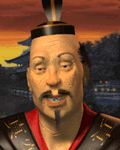The Japanese |
|||||||||||||||||||||||
| Profile | |||||||||||||||||||||||
|
|||||||||||||||||||||||
|
Japanese Cities
Great Leaders
|
Background
It is not known when humans first settled on the Japanese archipelago, but the Jomon people might be called proto-Japanese, and they were spread throughout the archipelago by 250 BC. The Yayoi culture that arose in Kyushu, while the Jomon culture was still evolving, spread gradually eastward, overwhelming the Jomon. Culturally, the Yayoi represents a notable advance and flourished for some five or six centuries, from the 3rd century BC to the 3rd century AD. The unification of Japan under the Yamato court, with the tenno (“Emperor of Heaven”) at its center, occurred around the mid-4th century. The 6th century reign of Kentai (507-531 AD) represents a decline of Yamato influence both at home and abroad; the period can be characterized by the growing accumulation of power by regional leaders and a weakening of royal influence. After the Onin War, the power of independent local leaders increased markedly, and in many instances deputies of great shugo houses usurped the domains of their superiors; a new type of feudal lord, the daimyo, took their place. This Sengoku (“Warring States”) period was marked by constant conflict among many such lords. The Yamato court was resuscitated by efforts made within the royal family itself, primarily the reforms of Prince Shotoku, who drafted the Seventeen-Article Constitution of 604 AD. The death of Shotoku in 622 prevented his Confucian ideals of government from bearing full fruit when the Soga family, regaining its former power, executed Shotoku’s son Yamashiro and all his family in 643. Two years later, princes Nakano and Nakatomi engineered a coup d’état within the palace, killing the Soga family and wiping out all forces opposed to the imperial family. They then set about establishing a system of centralized government with the emperor as absolute monarch that would last 1000 years. In the late Heian period, the more powerful of the Samurai gathered in or near the capital, where they served both the military needs of the emperor and also as bodyguards for the great noble houses. Emerging from provincial warrior bands, the aristocratic Samurai caste of the Kamakura period (1192-1333), with their military skills and deep pride in their stoicism, developed a disciplined culture distinct from the earlier, quiet refinement of the imperial court. During the Muromachi period (1338-1573) under the growing influence of Zen Buddhism, the samurai culture produced many uniquely Japanese arts that continue today. Eventually, from among these warring Samurai clans arose the able Tokugawa Takechiyo, founder of the Edo shogunate (1603-1867 AD), which ended the incessant conflicts and brought reform and peace to the islands. Although Spanish and Portuguese traders and missionaries had been in Japan since the mid-1500s, it was the arrival of a squadron of U.S. warships commanded by Commodore Matthew C. Perry in Uraga Bay in July 1853 that finally opened the nation to Western influence – and brought pressure for political reforms and a national identity. The Meiji government that followed the overthrow of the shogunate set about the task of westernization and the creation of a modern state, and moved Japan onto the world stage. Ironically, Japan’s new, influential role – marked by the ensuing Russo-Japanese War (1904-1905), Japan’s involvement in the First World War and in the Allied intervention in Siberia following the Bolshevik Revolution of 1918 – led indirectly to the attack on Pearl Harbor and the horrors that followed. The summer of 1945 brought disaster for the Japanese: the Americans took Okinawa in a bloody invasion, in August the Soviet Union declared war and swept over Manchuria, and atomic bombs largely destroyed the cities of Hiroshima and Nagasaki on August 6 and 9, respectively. The Pacific War came to an end on August 14, with the formal surrender signed on September 2 in Tokyo Bay aboard the battleship USS Missouri. With postwar American aid, from 1952 to 1973 Japan experienced accelerated economic growth and social change. By the 1990s, Japan was again a first-class power, the senior partner in the emerging Asian economic bloc. Unique Unit: the Samurai The Samurai is an upgraded version of the knight. Like the knight, it requires iron to build, but it does not require horses as the knight does. The Samurai has an additional defensive point, making it a powerful all-purpose unit which is equally suited for both assault and defense roles.
|
||||||||||||||||||||||

 The Japanese are religious and militaristic. They start the game with Ceremonial Burial and The Wheel and build samurai instead of knights.
The Japanese are religious and militaristic. They start the game with Ceremonial Burial and The Wheel and build samurai instead of knights.  Similar to the European knights, Japanese samurai were landowners who volunteered military service in exchange for a larger warlord’s protection. Their handsome laquer armor gave them durable protection on the battlefield. The warrior code of "Bushido" placed exacting restrictions on their behavior, both on the field of battle and off. One such tenant was that samurai of opposing forces must seek each other out and battle one on one. While their armor provided some safety from early gunpowder weapons, soon more advanced weaponry and skilled marksmen relagated them to admistrative and leadership roles. The samurai caste was abolished in 1868.
Similar to the European knights, Japanese samurai were landowners who volunteered military service in exchange for a larger warlord’s protection. Their handsome laquer armor gave them durable protection on the battlefield. The warrior code of "Bushido" placed exacting restrictions on their behavior, both on the field of battle and off. One such tenant was that samurai of opposing forces must seek each other out and battle one on one. While their armor provided some safety from early gunpowder weapons, soon more advanced weaponry and skilled marksmen relagated them to admistrative and leadership roles. The samurai caste was abolished in 1868.